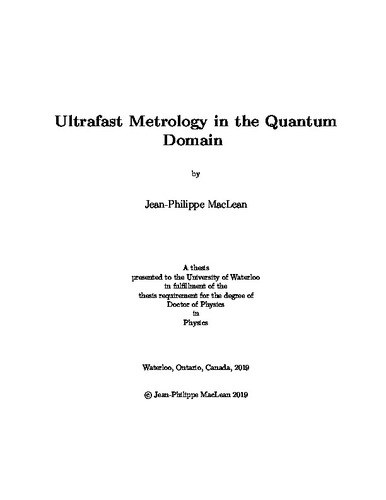| dc.description.abstract | Single photons are a natural platform for quantum technologies as they support entanglement in many degrees of freedom and are inherently well protected from a detrimental type of noise called decoherence. In order to fully exploit photons for quantum technologies, it will be necessary to be able to shape, control, and measure their properties in all degrees of freedom: space, time, frequency, and polarization.
The time-frequency degree of freedom of light is of particular interest for quantum information tasks as it supports various encodings, including frequency bins and time bins, and is intrinsically robust for propagation through long-distance fibre links. Applications which harness quantum correlations in this degree of freedom, referred to as energy-time entanglement, include dispersion cancellation and high-dimensional quantum key distribution. However, detection of this entanglement and observation of these effects requires time resolution beyond the capabilities of current photon detectors. Thus, for operations on ultrafast time scales, more powerful and complex methods are required.
In this thesis, we use a nonlinear technique known as optical gating to surpass the limitations in current detectors and measure single photon pairs, improving the time resolution by two orders of magnitude. When a single photon enters a nonlinear medium at the same time as a strong laser pulse, it may upconvert to a higher energy photon. The strong laser pulse effectively acts as an ultrafast shutter or gate and this creates a high resolution snapshot of the photon in time. Optical gating in conjunction with single photon spectrometers then allow us to measure both the spectral and temporal features of photons on subpicosecond time scales.
These high resolution measurements enable us to explore a host of quantum effects which remained previously inaccessible. First, we directly observe energy-time entanglement, analogous to Einstein-Rosen-Podolsky correlations but \emph{in frequency and time}. Then, with full control over the dispersion of each photon, we observe nonlocal dispersion cancellation on femtosecond time scales. We also explore ultrafast interferometry in the quantum domain by temporally resolving two-photon interference from a Franson interferometer and observe a violation of the CHSH-Bell inequality. Finally, we show that, using these measurements, it is possible to reconstruct a two-photon energy-time entangled state. Such measurement capabilities will be essential to precisely control both the spectral and temporal shape of entangled photons and to develop new applications in quantum state engineering. | en |

